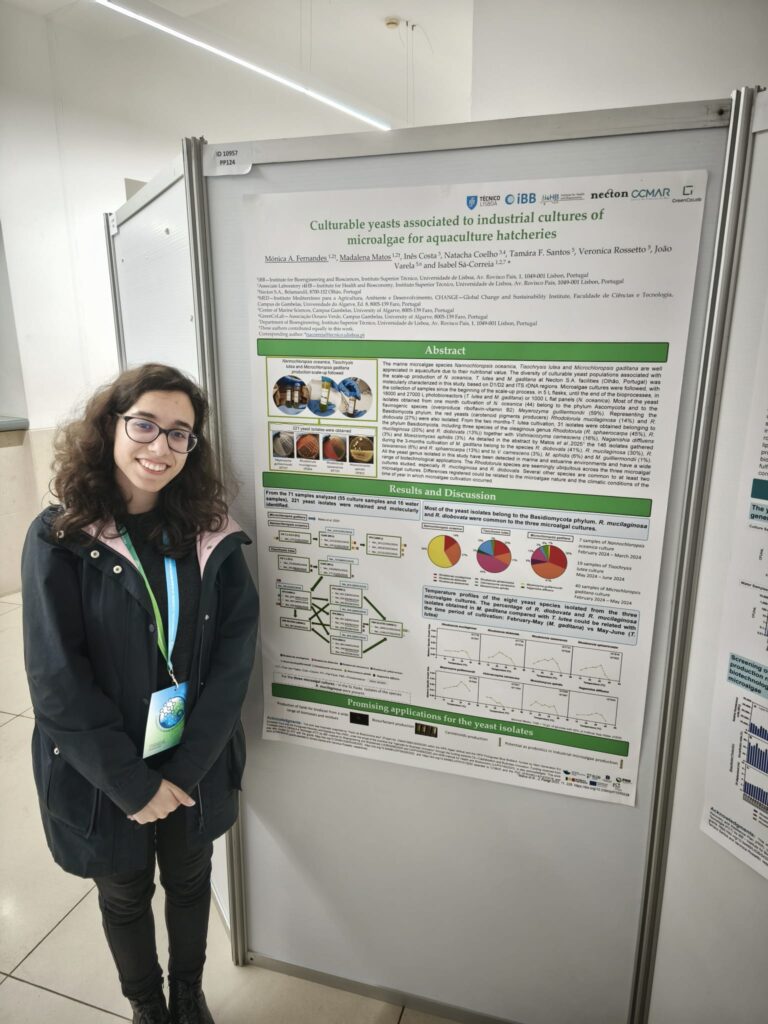Your cart is currently empty!
Poster presentation in the 1st International Congress on Algae Biotechnology – Mónica Fernandes
—

Title
Culturable yeasts associated to industrial cultures of microalgae for aquaculture hatcheries
Authors
Mónica A. Fernandes, Madalena Matos, Inês Costa, Natacha Coelho, Tamára F. Santos, Veronica Rossetto, João Varela, Isabel Sá-Correia
Abstract
The marine microalgae Nannochloropsis oceanica, Tisochrysis lutea and Microchloropsis gaditana are well known microalgae species, being considered promising as feed in aquaculture due to their high percentage of fatty acids. The productivity of microalgal cultures is heavily dependent on microbial contamination. Nevertheless, there is a lack of comprehensive knowledge on the mechanisms of algae-microbial interactions, even for the more well-studied associated bacteria. In this study, we aimed to characterize the culturable yeast population associated with the scale-up production of Nannochloropsis oceanica, Tisochrysis lutea and Microchloropsis gaditana at Necton S.A. facilities (Olhão Portugal). The microalgae cultures were followed, with the collection of samples before and after the passage to new reactors, since the beginning of the scale-up process, in 5 L flasks, until the end of production, in photobioreactors (T. lutea/M. gaditana) or flat panels (N. oceanica). In some cases, a sterilized water sample was also collected before inoculation of a new reactor. The N. oceanica culture was followed for 1 month with the collection of seven samples from which 44 yeast isolates were obtained and molecularly identified. Most of the yeast isolates belong to the phylum Ascomycota and to the species Meyerozyma guilliermondii (59%). Two species of the Basidiomycota phylum were identified, both from the genus Rhodotorula – Rhodotorula mucilaginosa (14%)and R. diobovata (27%). The T. lutea culture was followed for 2 months with the collection of 30 samples, resulting in the identification of 53 yeast isolates. All isolates belong to the phylum Basidiomycota, including three species of the genus Rhodotorula – R. sphaerocarpa (26%), R. mucilaginosa (19%) and R. diobovata (8%) – as well as Vishniacozyma carnescens (42%), Naganishia diffluens (2%), Moesziomyces aphidis (2%)and Cystobasidium slooffiae (2%). The M. gaditana culture was followed for 3 months with the collection of 40 samples, resulting in the identification of 146 yeast isolates. The majority of the isolates belong to the phylum Basidiomycota (99%), including four species of the genus Rhodotorula – R. diobovata (41%), R. mucilaginosa (30%), R. taiwanensis (6%) and R. sphaerocarpa (13%) –Vishniacozyma carnescens (3%) and Moesziomyces aphidis (6%). In the phylum Ascomycota, only Meyerozyma guilliermondii (1%) was identified. All the yeast genus isolated in this study have been detected in marine and estuarine environments and have a wide range of biotechnological applications. The Rhodotorula species are seemingly ubiquitous across the three microalgal cultures studied, especially R. mucilaginosa and R. diobovata. Several other species are common to at least two microalgal cultures. However, there is a lack of uniformity in their time distribution, indicating a possible variance depending on climate.The exploitation of promising yeasts, associated with marine and estuarine environments, capable of co-producing high-value products and of creating positive symbiosis with microalgae species is an important objective to be achieved in the context of the circular bioeconomy.
